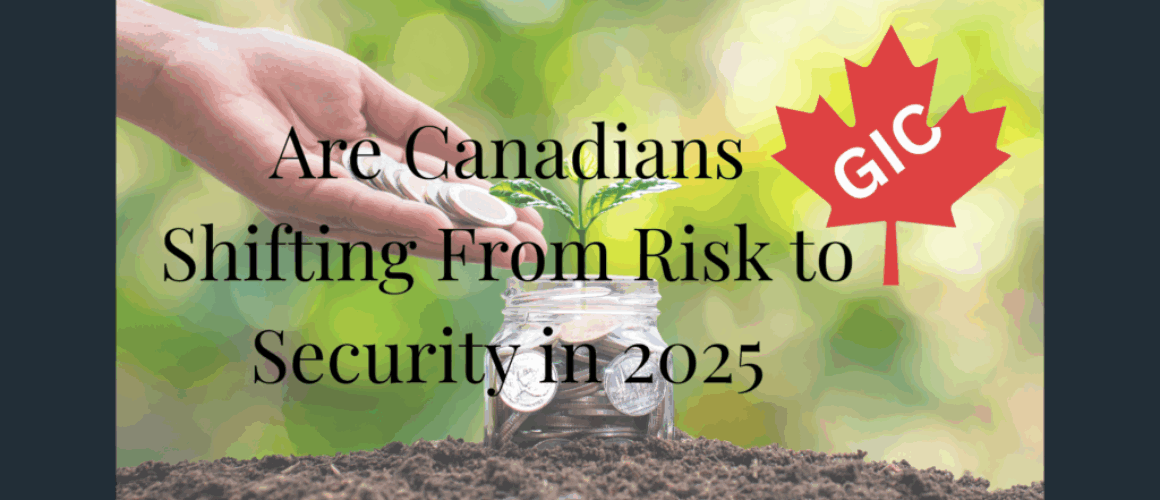The Return of the 5% GIC – Are Canadians Shifting From Risk to Security in 2025?

In a financial environment once dominated by low interest rates, aggressive investing, and FOMO-fueled speculation, something unexpected has returned to the spotlight: the humble Guaranteed Investment Certificate (GIC). Once relegated to the conservative corners of the portfolio — often seen as the domain of retirees and risk-averse savers — GICs are back, and they’re booming.
The reason? Rising central bank rates, growing market volatility, and deep public fatigue with economic uncertainty have made 5%+ GICs not only attractive again — but in some cases, preferable to risk-based returns.
From Forgotten to Favored
In 2021, GICs were barely yielding 1%. Today, some five-year GICs are offering returns above 5.4%, with one- and two-year options commonly exceeding 4.8%. At those rates, after-tax returns on GICs have become competitive with — and in some cases more reliable than — dividend stocks, corporate bonds, and even REITs.
Canadian banks and credit unions are capitalizing on the trend. BMO, Tangerine, and Simplii Financial have all launched “High-Interest GIC” campaigns in Q2 2025, targeting everyone from millennials saving for their first home to boomers looking to de-risk post-retirement portfolios.
According to a report from the Investment Funds Institute of Canada (IFIC), $19.7 billion flowed into GICs and money market instruments in the first quarter of 2025 alone — the highest since 2008.
Who’s Buying — And Why?
The renewed appetite for GICs cuts across demographics. For younger Canadians, the appeal lies in certainty. After years of volatile meme stocks, crypto losses, and housing price swings, the idea of locking in a safe 5% return feels, in a word, revolutionary.
“GICs give me something my TFSA investments don’t: peace of mind,” says Nicole Henry, a 32-year-old teacher in Halifax. “I know exactly how much I’ll earn, and I don’t need to check a stock ticker.”
Retirees and near-retirees, meanwhile, are restructuring portfolios to preserve capital amid fears of rate-induced recessions. Financial advisors report that many clients are now splitting retirement funds into “laddered GIC portfolios” — staggering maturity dates to maintain liquidity and lock in the highest rates at each term length.
Even traditionally risk-tolerant investors are hedging with GICs, using them to balance more aggressive bets in a two-tier portfolio.
GICs vs. Inflation: The Real Rate Debate
One criticism that still follows GICs is their relationship with real returns — returns adjusted for inflation. With inflation hovering around 2.6%, a 5.2% GIC effectively yields 2.6% in real terms. While positive, it’s still modest when compared to long-term equity returns.
But in today’s risk-adjusted context, that tradeoff feels acceptable. “It’s not just about beating inflation anymore,” says Raj Malhotra, a wealth advisor in Ottawa. “It’s about predictability, and GICs are winning that psychological battle.”
Another key shift? GICs are no longer being treated as “parking tools” — they’re being built into strategy. Wealth managers are using them for down payment timelines, tuition funds, emergency savings buffers, and bond-alternative allocations.
Digital Innovation and Flexibility
The new generation of GIC products is also more flexible. Some financial institutions are offering “cashable GICs” with partial liquidity, while others offer tiered-rate GICs that increase yield if held to full term.
Digital-native banks have pushed this trend further. Neo Financial recently introduced an in-app GIC selector that helps customers compare products across Canada and apply in one click. RBC and Scotiabank are piloting GIC-linked debit cards for seniors — blending security with spendability.
The evolution of GICs isn’t just in the rates — it’s in the user experience, making them more attractive to a tech-savvy generation used to ease and speed.
Conclusion: A Safe Bet in a Stormy Market
In a world of economic whiplash, Canadians are rediscovering the value of safe, structured, and secure investments. The GIC — long ignored in bull markets — is having a renaissance, not just as a savings product, but as a strategy for risk-managed living.
While it won’t replace equities or redefine aggressive growth portfolios, the GIC is proving that in 2025, a boring investment might be the smartest one.